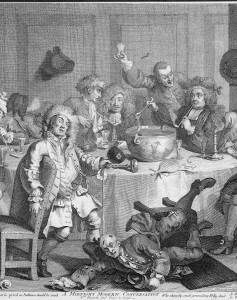 The true enjoyer of wine finds it exhilarate[s] the spirits, increase[s] the memory, promote[s] cheerfulness; if he be something of a wit, it draws out his hoarded stores of good sayings and lively repartees . . .This cheerful glass calls into action his better natural qualities, as with the ruby liquor he swallows ‘a sunbeam of the sky’ . . . he leaves the table to mingle with beauty . . . perhaps to bask in ‘the purple light of love.’ . . . [However, he] who would destroy good wine, by taking it when its flavour is no longer fresh to the palate, is a drunkard.
The true enjoyer of wine finds it exhilarate[s] the spirits, increase[s] the memory, promote[s] cheerfulness; if he be something of a wit, it draws out his hoarded stores of good sayings and lively repartees . . .This cheerful glass calls into action his better natural qualities, as with the ruby liquor he swallows ‘a sunbeam of the sky’ . . . he leaves the table to mingle with beauty . . . perhaps to bask in ‘the purple light of love.’ . . . [However, he] who would destroy good wine, by taking it when its flavour is no longer fresh to the palate, is a drunkard.
Cyrus Redding, Every Man His Own Butler (London, 1839)
It can be difficult to gauge what percentage of an adult’s beverage consumption in the past was made up of wine. From the 1600s onward, detailed import and export records do survive, but they reveal little about the domestically produced beverages that were being drunk. Preferences depended on availability, cultural background, personal taste, and the size of one’s pocketbook. Throughout much of the colonial period, imported wines were more widely enjoyed by the moneyed classes, but beer, ale, cider, and other beverages were consumed by almost everyone. Like wines, these varied in quality and price tag but could also be made fairly inexpensively at home.
Many cookbooks offered wine recipes. Eliza Smith’s popular Compleat Housewife; or, Accomplished Gentlewoman’s Companion (London, 1727), was reprinted many times. In 1742 the Williamsburg, Virginia, edition became the first cookbook to be published in America. Among its 600 recipes are more than two dozen for “made wines” using fruit—from grapes to “apricocks,” cherries, quinces, and raspberries—as well as flowers. Also included are recipes for mead (from honey), ale, cider, and beer.
Period documents are an important and often entertaining aid to understanding private and public usage of drinking glasses, bottles, decanters, and other accoutrements. Journal references and estate inventories as well as advertisements, articles, and books provide evidence of availability and how such goods fit into everyday life and special occasions. Archaeological evidence also plays an important part in understanding object distribution.
Related Themes:
